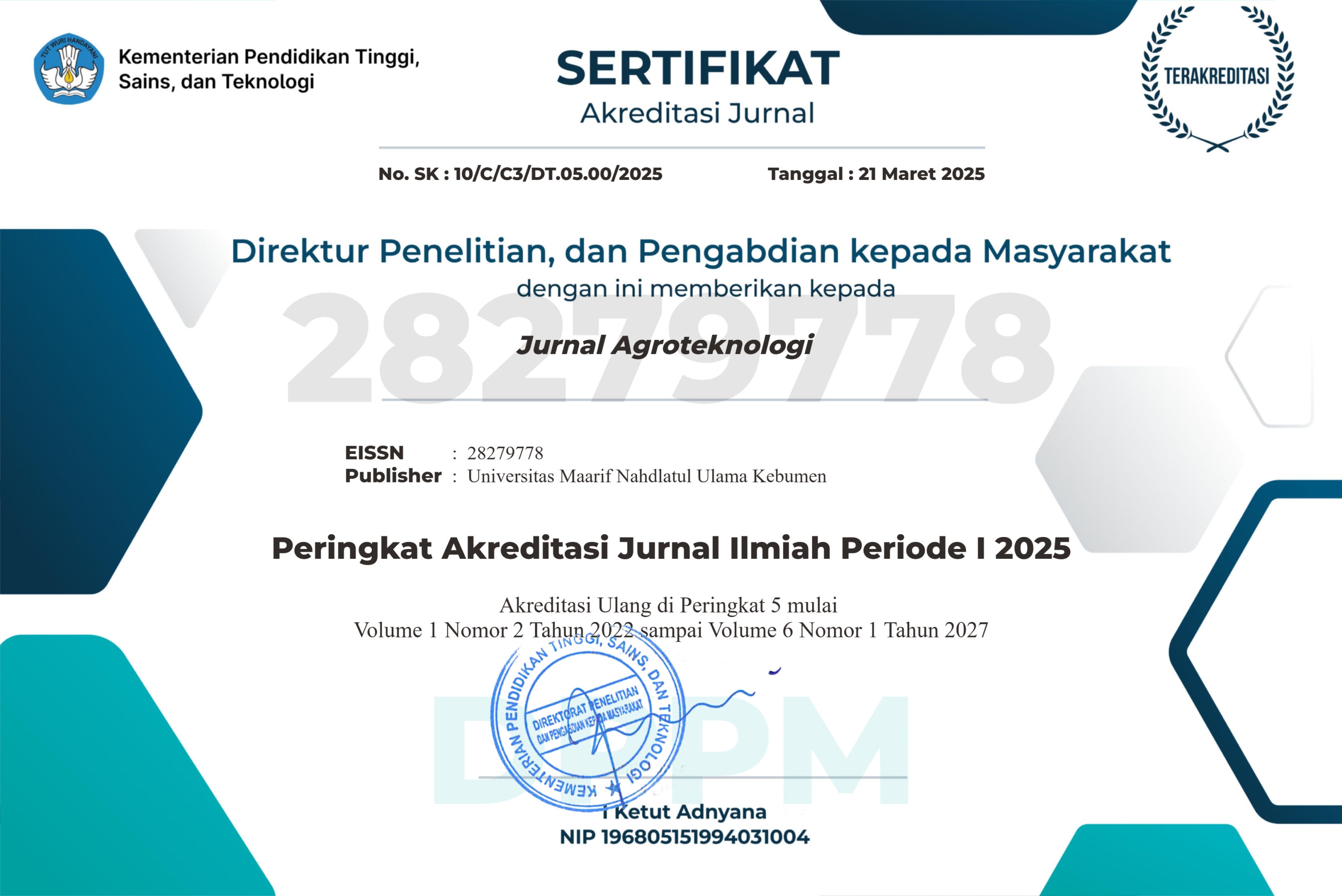Comparative Effects of Organic and Inorganic Fertilization with Mycorrhizal Inoculation on the Growth and P-Uptake of Salak (Salacca zalacca) Seedlings in a Compost-Amended Andisol
DOI:
https://doi.org/10.53863/agronu.v5i01.1796Keywords:
Andisol, Arbuscular mycorrhiza, Liquid organic fertilizer, Phosphorus fixation, SalakAbstract
The cultivation of salak (Salacca zalacca) on Andisols is constrained by low phosphorus (P) availability due to the soil's high P-fixation capacity. To evaluate strategies for enhancing P uptake, a 180-day greenhouse experiment was conducted using a factorial completely randomized design. Salak seedlings were grown in a compost-amended Andisol (2:1 v/v) and subjected to three fertilizer treatments (control [P0], liquid organic fertilizer [P1], and inorganic NPK [P2]) combined with three dosages of a Glomus-based arbuscular mycorrhizal fungi (AMF) inoculum (0 g [M0], 30 g [M1], and 60 g [M2] polybag⁻¹). The results revealed distinct treatment effects on soil, microbial, and plant parameters. In the soil, the inorganic NPK fertilizer (P2) induced significant acidification (pH 6.17), while the liquid organic fertilizer (P1) maintained a more neutral pH (7.03); however, final soil-available P was not significantly different among treatments. Biologically, the P2 treatment severely suppressed the mean mycorrhizal infection rate to 20.0%, significantly lower than the 53.3% observed under the P1 treatment. These effects directly translated to plant growth, where P1 produced significantly taller plants and greater fresh weight, and the P1M2 combination yielded the longest roots (42.43 cm). Ultimately, these improvements culminated in superior plant nutrition, with the P1 treatment facilitating the highest P uptake (0.145 g/plant), nearly double that of the P2 treatment (0.073 g/plant). The findings systematically demonstrate that an integrated approach using liquid organic fertilizer and AMF inoculation is a superior strategy for enhancing nutrient uptake efficiency and promoting vigorous growth in salak nurseries on P-fixing Andisols
References
Amujoyegbe, B. J., Opabode, J. T., & Olayinka, A. (2007). Effect of organic and inorganic fertilizer on yield and chlorophyll content of maize (Zea mays L.) and sorghum (Sorghum bicolor L. Moench). African Journal of Biotechnology, 6(16), 1869–1873. http://www.ajol.info/index.php/ajb/article/viewFile/57814/46181
Andraski, T. W., & Bundy, L. G. (2003). Relationships between phosphorus levels in soil and in runoff from corn production systems. Journal of Environmental Quality, 32, 310–316. https://doi.org/10.2134/jeq2003.3100
Aziz, A., Muyassir, & Bakhtiar. (2012). Perbedaan jarak tanam dan dosis pupuk kandang terhadap sifat kimia tanah dan hasil padi sawah (Oryza sativa). Jurnal Manajemen Sumber Daya Lahan, 1(2), 120–125. http://jurnal.unsyiah.ac.id/MSDL/article/view/2179/2136
Balai Penelitian Tanah. (2005). Petunjuk teknis analisis kimia tanah, tanaman, air, dan pupuk. Badan Penelitian dan Pengembangan Pertanian, Departemen Pertanian.
Brady, N. C., & Weil, R. R. (2004). Elements of the nature and properties of soils (7th ed.). Pearson Education.
Brady, N. C., & Weil, R. R. (2007). The nature and properties of soils (14th ed.). Pearson Education Pte. Ltd.
Dariah, A., & Sukarman. (2014). Tanah Andisol di Indonesia: Karakteristik, potensi, kendala dan pengelolaannya untuk pertanian. Balai Besar Penelitian dan Pengembangan Sumberdaya Lahan Pertanian.
de Bang, T. C., Husted, S., Laursen, K. H., Persson, D. P., & Schjoerring, J. K. (2021). The molecular–physiological functions of mineral macronutrients and their consequences for deficiency symptoms in plants. New Phytologist, 229(4), 2446–2469. https://doi.org/10.1111/nph.17074
Declerck, S., Strullu, D. G., & Fortin, J. A. (2005). In vitro culture of mycorrhizas. Springer.
Delvian. (2006). Peranan ekologi dan agronomi cendawan mikoriza arbuskular. Universitas Sumatera Utara. http://library.usu.ac.id/download/fp/06005281.pdf
Devau, N., Cadre, E. L., Hinsinger, P., Jaillard, B., & Gérard, F. (2009). Soil pH controls the environmental availability of phosphorus: Experimental and mechanistic modelling approaches. Applied Geochemistry, 24(11), 2163–2174. https://doi.org/10.1016/j.apgeochem.2009.09.020
Dharmayanti, N. K. S., Supadma, A. A. N., & Arthagama, I. D. M. (2013). Pengaruh pemberian biourine dan dosis pupuk anorganik (N, P, K) terhadap beberapa sifat kimia tanah pegok dan hasil tanaman bayam (Amaranthus sp.). Jurnal Agroekoteknologi Tropika, 2(3), 165–174. http://ojs.unud.ac.id/index.php/JAT/article/view/6077/4571
Direktorat Jenderal Perdagangan. (2014). Warta ekspor (Ed. Desember 2014). Kementerian Perdagangan. http://djpen.kemendag.go.id/app_frontend/admin/docs/publication/3971421058470.pdf
Djaenudin, D., Marwan, H., Subagjo, H., & Hidayat, A. (2011). Petunjuk Teknis Evaluasi Lahan untuk Komoditas Pertanian (Edisi kedua). Balai Besar Penelitian dan Pengembangan Sumberdaya Lahan Pertanian.
Dwijoseputro. (1994). Pengantar fisiologi tumbuhan. Rajawali Pers.
Gianinazzi, S., Gollotte, A., Binet, M. N., Tuinen, D., Redecker, D., & Wipf, D. (2010). Agroecology: The key role of arbuscular mycorrhizas in ecosystem services. Mycorrhiza, 20(8), 519–530. https://doi.org/10.1007/s00572-010-0333-3
Gregory, P. (2006). Plant roots: Growth, activity and interaction with soils. Blackwell Publishing.
Hammond, J. P., & White, P. J. (2008). Sucrose transport in the phloem: Integrating root response to phosphorus starvation. Journal of Experimental Botany, 59(1), 93–109. https://doi.org/10.1093/jxb/erm221
Hammond, J. P., Broadley, M. R., White, P. J., King, G. J., Bowen, H. C., Hayden, R., Meacham, M. C., Mead, A., Overs, T., Spracklen, W. P., & Greenwood, D. J. (2009). Shoot yield drives phosphorus use efficiency in Brassica oleracea and correlates with root architecture traits. Journal of Experimental Botany, 60(7), 1953–1968. https://doi.org/10.1093/jxb/erp083
Havlin, J. L., Beaton, J. D., Nelson, S. L., & Nelson, W. L. (2005). Soil fertility and fertilizers: An introduction to nutrient management. Pearson Prentice Hall.
Ingestad, T. (1973). Mineral nutrient requirement of cucumber seedlings. Plant Physiology, 52(4), 332–338. https://doi.org/10.1104/pp.52.4.332
Komala, S. (2024). Statistik terkini ekonomi pertanian Maret 2024. Pusat Data Sistem Informasi Pertanian, Sekretariat Jenderal, Kementerian Pertanian, Republik Indonesia.
Mahdi, S. S., Hasan, G. I., Samoon, S. A., Rather, H. A., Showkat, A. D., & Zehra, B. (2010). Bio-fertilizer in organic agriculture. Journal of Phytology, 2(10), 42–54.
Montalba, R., Arriagada, C., Alvear, M., & Zuniga, G. E. (2010). Effects of conventional and organic nitrogen fertilizers on soil microbial activity, mycorrhizal colonization, leaf antioxidant content, and Fusarium wilt in highbush blueberry (Vaccinium corymbosum L.). Scientia Horticulturae, 125(4), 775–778. https://doi.org/10.1016/j.scienta.2010.04.046
Munawar, A. (2011). Kesuburan tanah dan nutrisi tanaman. IPB Press.
Nandariyah, Soemartono, Artama, W. T., & Taryono. (2004). Klasifikasi kultivar salak jawa berdasarkan sifat morfologi dan molekuler-RAPD. Agrosains, 6(2), 75–79.
Niu, Y. F., Chai, R. S., Jin, G. L., Wang, H., Tang, C. X., & Zhang, Y. S. (2013). Responses of root architecture development to low phosphorus availability. Annals of Botany, 112(2), 391–408. https://doi.org/10.1093/aob/mcs285
Novriani. (2010). Inokulasi mikoriza arbuskular pada bibit kelapa sawit (Elaeis guineensis Jacq.) yang ditanam pada berbagai komposisi media tanam. Agronobis, 2(4), 30–42.
Raharjo, G., Saidi, D., & Afany, M. R. (2022). Soil quality in cultivation land of snakefruit (Salacca edulis) in Ledoknongko, Bangunkerto village, Turi, Sleman Yogyakarta Indonesia. International Journal of Scientific Engineering and Science, 6(5), 27–31.
Reuter, D. J., & Robinson, J. B. (1986). Plant analysis: An interpretation manual. Inkata Press.
Sanchez, P. A. (1976). Sifat dan pengelolaan tanah tropika. Institut Teknologi Bandung Press.
Sari, D. A., Akbar, H., Nasruddin, Hafifah, & Ismadi. (2025). Evaluasi kesesuaian lahan tanaman salak (Salacca zalacca) di Kota Sabang. Jurnal Agrium, 22(2), 161–171.
Smith, S. E., Smith, F. A., & Jakobsen, I. (2003). Mycorrhizal fungi can dominate phosphate supply to plants irrespective of growth responses. Plant Physiology, 133(1), 16–20. https://doi.org/10.1104/pp.103.024380
Suhariyono, G., & Yurizon, M. (2005, July 12). Analisis karakteristik unsur-unsur dalam tanah di berbagai lokasi menggunakan XRF [Paper presentation]. Seminar Nasional, Puslitbang Teknologi Maju, BATAN, Yogyakarta, Indonesia.
Sumarni, N., Rosilani, R., Basuki, R. S., & Hilman, Y. (2012). Respons tanaman bawang merah terhadap pemupukan fosfor pada beberapa tingkat kesuburan lahan (Status P-Tanah). Jurnal Hortikultura, 22(2), 130–138. https://www.ejurnal.litbang.pertanian.go.id/index.php/jhort/article/view/739/563
Supadma, A. N. (2006). Uji kombinasi pupuk organik dan anorganik terhadap hasil jagung manis serta kepadatan tanah Inceptisol Tabanan. Agritrop, 25(2), 51–56.
Takahashi, Y., & Katoh, M. (2024). Root response and phosphorus acquisition under partial distribution of phosphorus and water‐soluble organic matter. Soil Use and Management, 40(1), e13038. https://doi.org/10.1111/sum.13038
Vu, D. T., Tang, C., & Armstrong, R. D. (2009). Tillage system affects phosphorus form and depth distribution in three contrasting Victorian soils. Australian Journal of Soil Research, 47(1), 33–45. https://doi.org/10.1071/SR08108
Wijayani, A., & Widodo, W. (2005). Usaha meningkatkan kualitas beberapa varietas tomat dengan sistem budidaya hidroponik. Jurnal Ilmu Pertanian, 12(1), 77–83.
Downloads
Published
How to Cite
Issue
Section
License
Copyright (c) 2025 Anasrullah Anasrullah, Nandariyah Nandariyah, Sri Hartati

This work is licensed under a Creative Commons Attribution-ShareAlike 4.0 International License.
Authors retain copyright and grant the journal right of first publication with the work simultaneously licensed under a Creative Commons Attribution-ShareAlike 4.0 International License that allows others to share the work with an acknowledgment of the work’s authorship and initial publication in this journal











